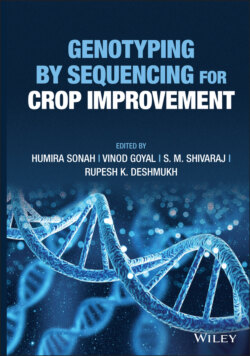Читать книгу Genotyping by Sequencing for Crop Improvement - Группа авторов - Страница 14
1.2 What is a Molecular Marker?
ОглавлениеDNA or molecular marker is a fragment of the DNA that is associated with a particular trait in an individual. These molecular markers aid in determining the location of genes that control key traits.
Generally, molecular markers do not represent the gene of interest but act as “flags” or “signs.” Similar to genes, all the molecular markers occupy a specific position within the chromosomes. Molecular markers located close to genes (i.e. tightly linked) are referred to as “gene tags.”
DNA‐based molecular markers are the most widely used markers predominantly due to their abundance. They arise from different classes of DNA mutations such as substitution mutations (point mutations), rearrangements (insertions or deletions), or errors in replication of tandemly repeated DNA. These markers are selectively neutral because they are usually located in noncoding regions of DNA. Unlike morphological and biochemical markers, DNA markers are practically unlimited in number and are not affected by environmental factors and/or the developmental stage of the plant.
DNA markers show genetic differences that can be visualized by using a gel electrophoresis technique and staining ethidium bromide or hybridization with radioactive or colorimetric probes. Markers that can identify the difference between two individuals are referred to as polymorphic markers, whereas those that do not distinguish the individuals are called monomorphic markers. Based on how polymorphic markers can discriminate between individuals, they are described as codominant or dominant. Codominant markers indicate differences in size whereas dominant markers reveal differences based on their presence or absence. The different forms of a DNA marker in the form of band size on gels are known as marker “alleles.” Dominant marker has only two alleles whereas codominant markers may have many alleles.
